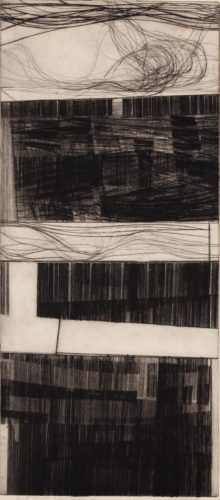11 May 2020
Works from the Collection: Robert Steele
Robert Steele
Earth Structure, 1965
drypoint etching
Collection of the Morris and Helen Belkin Art Gallery, gift of Leon and Joan Tuey, 1997
Drypoint etching is usually done on copper, with lines scratched directly into the softer metal plates. A special diamond-tipped needle is used to “draw” directly onto the plate, pushing up the copper on either side to create a ridge – or burr – that holds the ink during the printing process. When the ink that has been applied to the plate is wiped off, both the incised line and specifically the burr receive ink, thus giving the printed line its characteristic velvety fuzziness. Earth Structure is an amazing organization of these shadowy, hair-like lines, some of them gridded into almost opaque black sections. I can remember using this series of my father’s as inspiration in art school – using powerful blocks of black ink juxtaposed with my own imagery.
Robert (Bob) Steele (1925-2018) was born in Mervin, SK. He served in the RCAF, received Education and Arts degrees from the University of Saskatchewan and began his longstanding teaching career in four one-room rural schools before moving to Vancouver in 1961 to teach at the Vancouver School of Art and later at UBC’s Faculty of Education. At UBC, Steele taught studio printmaking and art education for twenty-eight years, during which time he exhibited prints, drawings, paintings and photographs locally and nationally. He was a master printer, excelling at etching, and was part of Vancouver’s struggle to be modern. After retiring in 1990, Steele began the Drawing Network to encourage children to draw as a means of fostering literacy and improving emotional and mental health. Steele held that that, “Children use spontaneous drawing to articulate, express and communicate their most complex, meaningful and heartfelt perceptions, thoughts and feelings.”
Works from the Collection considers one work in the Belkin’s permanent collection that particularly inspires us; at this moment in May 2020, we are looking at these works through the lens of the current crises around us. This round of Staff Picks is brought to you by David Steele, the Belkin’s Preparator since 1996. Dave installs all of the Belkin’s exhibitions, which includes using his specialized skills in building exact replicas of the Belkin as well as the myriad of accoutrements that are needed to realize each artist’s work. After work, Dave sees as many bands as he can. To see more of the Belkin’s collection, visit https://collection.belkin.ubc.ca.
